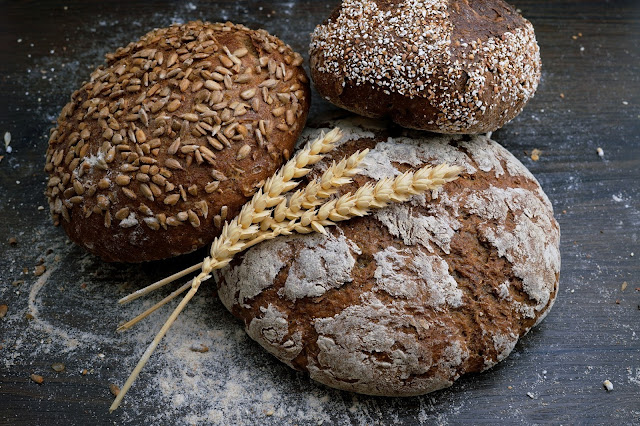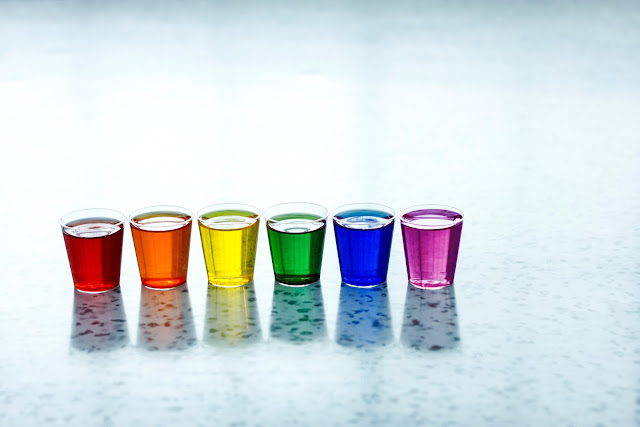Wheat, Bran, Germ, What?
 |
| Wesual Click |
I overheard someone in the grocery store the other day explaining to a friend how she mixes a bunch of different things into her doughs to make them healthier. "Whole wheat flour, wheat germ, sometimes wheat bran...". Her friend huffed, asking what's the difference. The first woman paused, as she realized she wasn't really sure. As I thought about it...I wasn't either.
I hence decided to address this very question in my next post. What really is the difference between whole grain, whole wheat, wheat germ and wheat bran? Read on to find out.
I hence decided to address this very question in my next post. What really is the difference between whole grain, whole wheat, wheat germ and wheat bran? Read on to find out.
Let's start by talking about wheat. Just wheat.
What's wheat? Yes, it's what the Little Red Hen harvested to make her bread. But what is it really? Wheat seeds are called kernels, from which the wheat plant grows. Each kernel consists of:
 |
| Source: skinnychef.com |
- an embryo called a germinate, or germ, which is the sprouting section of the seed and the most nutritious part of the kernel
- a thick outer coating called the bran, or the "roughage", which is highest in fibre
- a protein-rich endosperm, the largest part of the kernel
Back in the day, when milling wheat, the germ and bran were left with the endosperm, leaving flour more nutritionally complete. However, it was soon discovered that removing the germ extended the shelf life of flour. Nowadays, both the bran and germ are separated, leaving the endosperm to be milled into the white flour we use today. It's the least nutritious, but lasts longer on the shelves.
So what's whole wheat?
Whole wheat means that the entire kernel has been used: endosperm, bran and germ.
What's whole grain then?
 |
| Monika Grabkowska |
In the context of wheat, whole wheat and whole grain basically mean the same thing: all three parts of the kernel are retained. However, other whole grain products use the entire whole grain kernel of wheat or another grain, such as oats or barley.
Wheat bran...?
You guessed it. Wheat bran is made with the ground up bran coating of the wheat kernel.
And wheat germ...
Yep. Take the germinate of the kernel and grind that up instead.
EXTRAS:
What on earth is multigrain then? (Don't be fooled)
Multigrain probably sounds like the healthiest of all the options, because of that fancy-sounding prefix. But really, the term "multigrain" is almost like a ticket for technicality. It just means that multiple grains have been used...and not necessarily whole grains. In these cases, carefully reading labels is important.
Made "with" whole grains
"With" can mean a lot of things. With can mean one percent. Again, read carefully to make sure you're getting your nutritional worth, and not just buying something that's cleverly labelled.
Enriched flour
This one sounds healthy too, huh? But what this really means is that nutrients have been added into the end flour product to replace some of the nutrients that were lost in milling. But a lot of these are artificially produced, and still not all the nutrients that were stripped can be replaced. Whole wheat flour is still the best option.
The takeaway
 |
| Daniel Hansen |
The takeaway
Whole grain, or when it comes to wheat specifically, whole wheat will always be the best option nutritionally. Worst case, you can do like the woman at the supermarket and mix bran and germ into plain flour yourself. At least this time, we'll know what they all mean.
What did you think of this post? Drop a comment below. Until next time.
Stay peaceful,
Lexxie


My mom normally puts whole wheat in the flour when she makes bread or roti. I think to make it a little healthier.
ReplyDeleteGuilty! I thought multigrain was the healthiest too loll
ReplyDelete